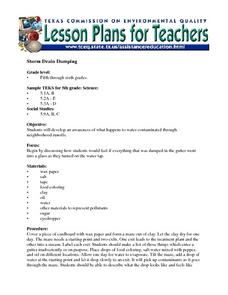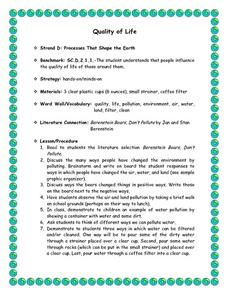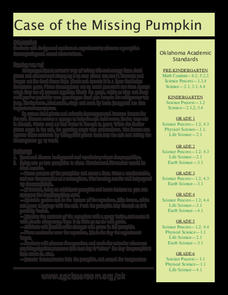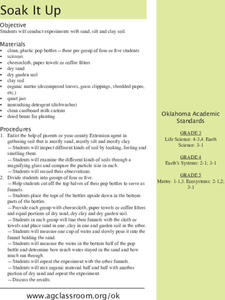Curated OER
Observing The Influence Of Acid Rain On Plant Growth
Young scholars observe one of the direct effects of acid water on plant growth. Students engage in an experiment which will take about 2 weeks. Young scholars will understand the effect that acid rain has on plant growth.
Curated OER
Soil Buffering
Pupils observe the pH change of an acid mixture poured over soil in a filter. Since the buffering capability of soils differs, you may want to do this experiment with several different soil types.
Virginia Polytechnic Institute and State University
Lesson Plan: Omelet Cooking Principles
Although designed for a foods lab, the information in this resource might be just the thing for your own recipe notebook. Illustrated, step-by-step directions for making the perfect omelet, egg-citing puzzles, games, and even...
Curated OER
Storm Drain Dumping
Students conduct an experiment to show how water gets contaminated through neighborhood runoffs.
Curated OER
Quality of Life
Learners discover that people influence the quality of life of those around them. They read the literature selection 'Berenstein Bears, Don't Pollute' and discuss the many ways people have changed the environment by polluting.
Curated OER
Amazing Salt
Learners examine the effects of salt on ice. For this salt lesson, students observe what happens to the temperature of ice when salt is added, then make ice cream to see how this knowledge can be used.
Curated OER
Ice
Students examine the different propereties of ice, such as freezing temperature. In this scientific lesson students complete several activities using ice, like making ice cream.
Curated OER
Why Should We Clean The Beach?
Students volunteer for the International Coastal Cleanup. They describe the purpose of the Lake Michigan Foundation and a history of the dunes. They reflect on their experiences with writing.
Curated OER
Scientific Method, Control and Variables
Middle school scientists bathe in Bikini Bottom with SpongeBob and friends. They define steps in the scientific method. They identify independent variables, dependent variables, and the control for science experiments being carried out...
Curated OER
Germs and the Importance of Washing Your Hands
Students observe what happens when bread is handled by dirty hands. They read and discuss the book "Germs." Students participate in an experiment. Students touch bread with a variation of hands: dirty, washed with soap and water, washed...
Curated OER
Observation Milk Fat Lesson
Turn your class loose to experiment with the different fat content in skim milk, whole milk, half and half, and heavy cream. This is a visually vibrant experiment, as learners drip food coloring on the surface of the products and measure...
Curated OER
What Is Viscosity?
Students experiment with the visocosity of corn syrup, mineral oil, vegetable oil, water, and honey. They research viscosity before beginning. Pupils draw the conclusion that the marble sinks more slowly in the liquids with greater...
Curated OER
Case of the Missing Pumpkin
Scientists define and discuss decomposition, and watch pumpkins decompose and return to soil in classroom experiment. They record the date the experiment began, chart changes in pumpkins on a calendar, count how many days it takes...
Curated OER
Dilution and Concentration of Solutions
Future chemists practice laboratory techniques by creating a monochloramine solution. The objectives are to use of dilution, 9concentration, and measurement skills and to prepare a solution that will be used in a water treatment...
Forest Foundation
Fire Investigation and Experimentation
Assess the probability of a wildfire with several lessons about fire danger ratings and risk factors. After experimenting with fuel moisture, learners explore the various elements that could contribute to a wildfire, such as wind speed,...
EduGAINs
Understanding Viscosity through Investigation and Comparison of Fluids
Not all liquids are the same. Investigate the viscosity of different fluids with a series of activities designed for eighth grade science. As learners move through learning centers with different experiment setups, they determine the...
Teach Engineering
Microbes Know How to Work!
Scholars harness the power of microbes with an engaging activity that uses yeast to break down sugar in water. Multiple setups of the same experiment lets learners determine which temperature results in the fastest rate of sugar...
Curated OER
Flame Tests
Learners perform flame tests on 12 elements. In this flame tests lesson plan, students experiment with elements to observe their visible light spectra emitted as electrons jump from one energy level to another. Learners record their...
Curated OER
Light, Colors, and Vision
Third graders experience optic illusions by creating flipbooks. In this optics lesson plan, 3rd graders view a demonstration of the workings of rods and cones using a camera. They are shown an optical illusion and work to create their...
Curated OER
Growing from Seed
High school or college horticulturists will appreciate this PowerPoint on seed-propagation. It walks them through the science behind seed production and germination as well as the requirements for growing plants from this stage....
Beyond Benign
Daphnia Bioassay LD50
De-icing materials may have a harmful effect on our environment; have your class perform an experiment to test the nature of these effects. Scholars monitor the survival rate of a sample of daphnia as the concentration of a de-icing...
Curated OER
Feel the Wonder
Students describe why clean water is important and how humans effect the quality of water in a community. They identify efforts in their community to keep the water clean. They participate in a water restoration movement in their area...
Curated OER
Ugh! We DRINK This Stuff?
Pupils explain the processes involved in the cleansing and purifying of surface water. After a lecture/demo, students engage in an experiment that illustrates how water is cleansed before we drink it.
Curated OER
Soak It Up
Learners examine the various materials that make up their local soils. In groups, they record how each material is different and use cheesecloth to filter them into a bottle based on particle size. They use the soils to determine if...

























